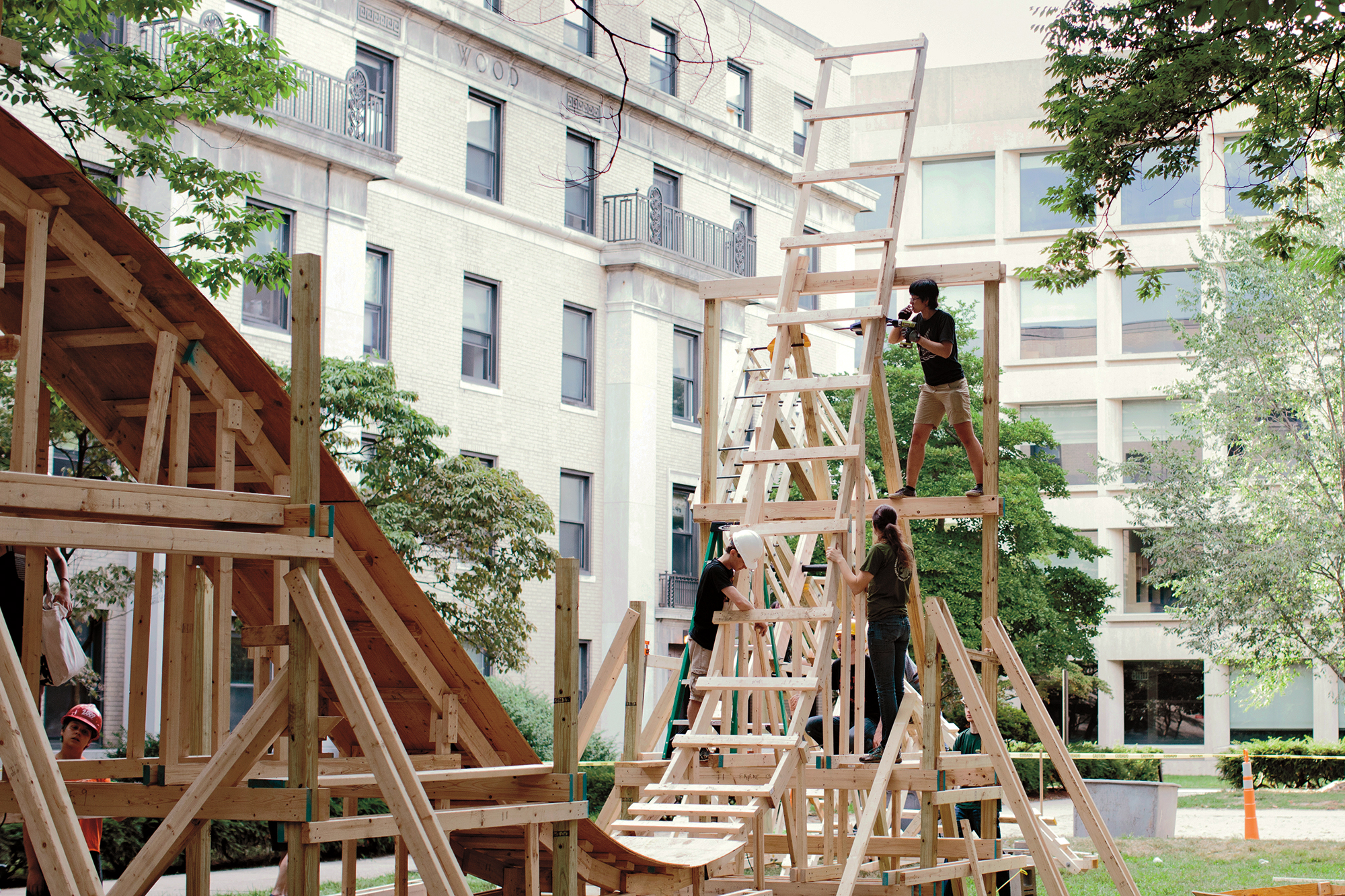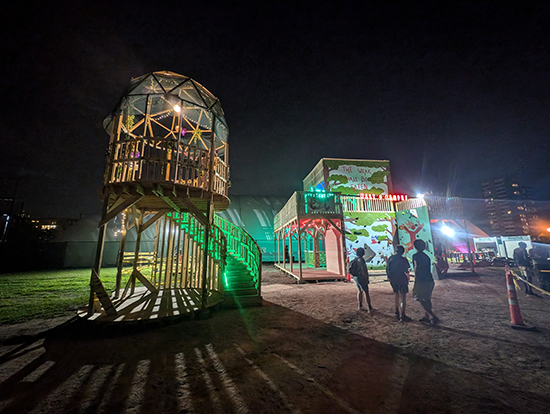Building Adventure at East Campus
-
-
Slice of MIT
Recommended

Roller coasters. Bouldering walls. Hamster wheels.
If you’re looking for a good example of MIT’s practical, hands-on approach to education—expressed in the motto Mens et manus, or “Mind and hand”—visit the courtyard of East Campus (EC) just as first-year students arrive on campus each fall. There you’ll find residents of the dormitory, one of the oldest and most beloved on MIT’s campus, building an astonishingly complex structure designed to entertain those newcomers—and show off the sense of community and building prowess that allow the dorm to pull off such feats year after year.
EC students and alums alike say the annual tradition of building giant rides exemplifies the camaraderie and can-do spirit of MIT. “[It] highlights everything I loved about living at EC—MIT allowing both resources and freedom for motivated people to come together to build cool things as a community,” says Ava Chen ’17.

The practice seems to have started in the early 2000s, although it’s hard to pin down the date since it took a few years to take root. Roller coasters—temporary but fully operational wooden rides—are the best-known results, but the designs vary from year to year. The fall 2024 build, for example, consisted of a three-story main structure with a bouldering wall, plus a “tree house” with a geodesic dome and spiral staircase. Although the projects usually happen in the East Campus courtyard, a space easily accessible to all residents, the 2023 and 2024 builds took place in a field near the Henry G. Steinbrenner ’27 Stadium while EC was undergoing renovations.
How it Started
Why do these building projects happen every year? It’s all a part of Residence Exploration Week (once known as rush, and now called REX)—a period when undergraduate halls across campus host activities before the start of the fall semester to help new students get to know the different living communities and choose the one that best suits them. The annual construction projects at East Campus give first-years a few reasons to check out the dorm. At the start of REX, they can stop by and learn safety rules for using power tools and even participate in the building process if they want to help. Then, once the structure is complete, they can try it out.
Not all dorms create something so elaborate to welcome first-years. But Mark Feldmeier ’96, SM ’03, PhD ’09, a former EC resident and an MIT Media Lab lecturer since 2009, explains that it wasn’t always like this at EC; small projects turned into bigger builds, and the enterprise slowly grew over time. In the ’90s, Feldmeier says, the dorm’s theme for rush week was “carnival”—complete with a dunk tank, a moon bounce, cotton candy, palm reading, and more—and anyone could set up a booth. “It was a good theme for EC, as it showcased the eccentricity and range of interests,” he says.

Toward the end of his time as an undergrad, Feldmeier and some friends started adding more large-scale carnival rides to the experience, culminating in an oversize robot combat project. A jumbo hamster wheel followed in 2001 and a 50-foot tower and giant pinball machine in 2002. Many more building projects in 2003 led to the first roller coaster in 2004—a project masterminded by Josh Powell ’06. The original roller coaster was named “8.01: The Ride,” paying homage to the course number for MIT’s introductory physics class.
“The ‘build rush’ would attract students who wanted to build things, which would increase the percentage of the dorm population who could design and contribute
to the process, allowing larger and larger builds,” says Feldmeier.
As the projects grew in size and scope, the Institute and the City of Cambridge got involved to ensure safety. It’s become standard procedure to get the city’s sign-off on the design before it’s built. And Feldmeier notes that David Barber, now MIT’s senior emergency management specialist, started working with students to make sure the builds met Occupational Safety and Health Administration standards and to develop a design approval process.
“The following years saw zip lines, lazy rivers, and giant catapults,” says Feldmeier.
More than Amusement Rides
For many incoming students, participating in the construction of an East Campus project helps them decide where to live—and for some, it also ignites a passion for building. Ben Katz ’16, SM ’18, says he heard about the projects during REX week and immediately got involved. “I spent most of my time during REX helping out with the builds in the EC courtyard,” he says.
Katz led the design of the 2014 roller coaster—the first to be fully vetted and approved by MIT and a professional structural engineer—and his design remains the backbone of the roller coasters EC builds today.
“The whole process was an adventure,” recalls Katz, who says the students worked nearly nonstop for about a week, dividing the structure into small sections that were built in parallel. “I was the first person to ride it. It was the first roller coaster I had ever ridden, and I’ve still never been on a ‘real’ roller coaster—only East Campus ones.”
The work was exciting and educational, Katz says. “Besides the fun of the whole project, it was definitely a unique learning experience. The huge design project, approval, the planning required to get the roller coaster built in a week, managing the build—all of these things at a scale I didn’t experience anywhere else as an undergrad.”
Chen says the EC builds are what initially drew her into the East Campus community, and she was involved in the projects during all four years at MIT, even serving as one of the project leads for the 2015 roller coaster. “Seeing the construction go on in the courtyard as a first-year was a definite source of joy and a big influence on my choice to live in EC,” she says. “The aspect of strong community at EC was a big draw for me at the time and also motivated me to continue these traditions as an upperclassman. And it definitely confirmed my interest in studying mechanical engineering.”
Looking back on EC’s REX planning process, which typically begins in January, Chen says it truly takes a village. “The construction period—the 2015 coaster took eight days from wood delivery to first ride—is a sprint at the end of a long marathon,” she says. “It was incredible how many people dedicated valuable time and effort to creating a whimsical project.” The EC dorm executive committee, EC alumni, and the MIT Environment, Health, and Safety Office helped guide them through “the structural safety calculations, budgeting, getting Cambridge Fire Department and City of Cambridge sign-offs, and all the other important details,” she adds. “It was an intense learning experience.”
East Campus might look a little different after renovations are completed in the fall, but the projects will continue. The Division of Student Life has worked closely with EC students to ensure that renovation architects have accommodated the needs of residents—and that includes design features to optimize REX builds. There will still be a plaza outside the building for constructing grand projects, and a makerspace—formerly housed in the basement of the building—will be located on the first floor, with direct access to the courtyard. One thing that is certain not to change is the innovative and playful spirit of the EC community.
“These projects were a really special part of East Campus culture, and one of the things that attracted me—and, I’m sure, many others—to the dorm in the first place,” Katz says. “They brought together a huge fraction of EC residents, between everyone running the projects, helping build them, grilling burgers in the courtyard to feed everyone. It really was a magical couple of weeks every year before the semester started.”
Photo (top): East Campus students work together to build a wooden roller coaster in the courtyard outside the dorm in 2015. Credit: M. Scott Brauer.
Watch a video of an EC roller-coaster build at technologyreview.com/rollercoaster.
This story also appears in the January/February issue of MIT Alumni News magazine, published by MIT Technology Review.







